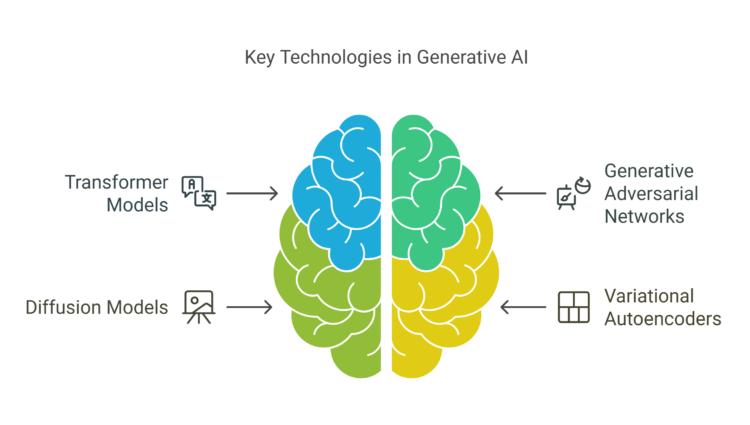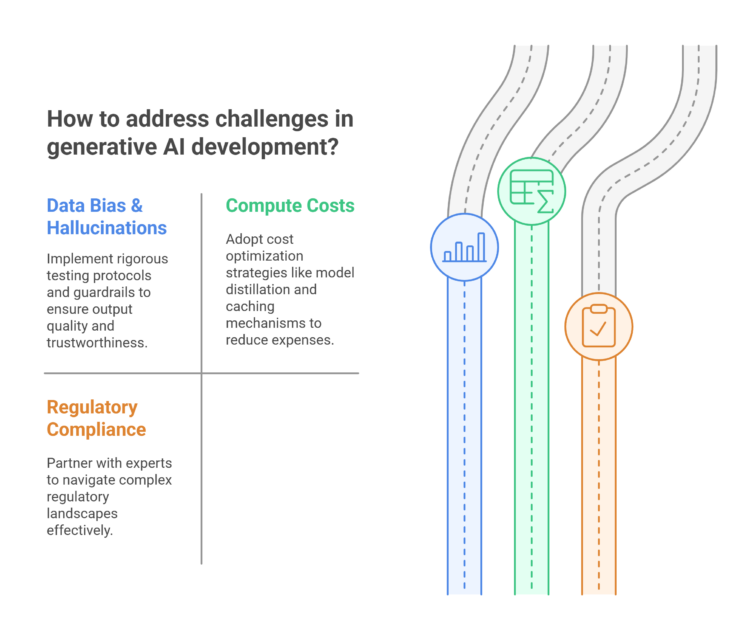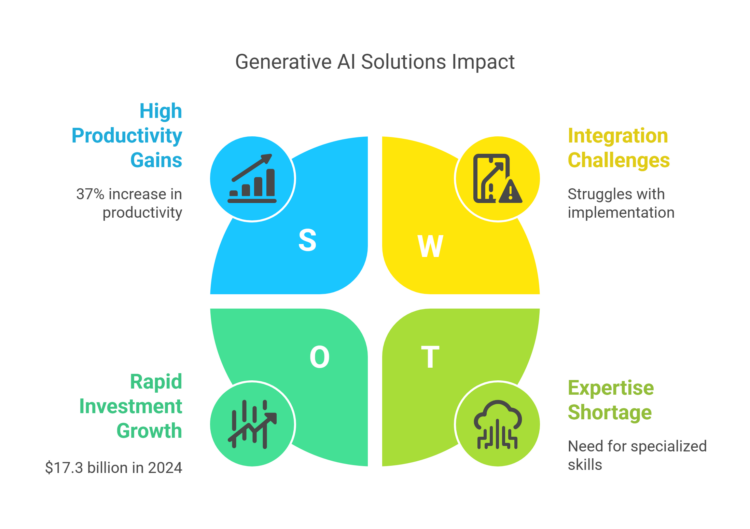
Generative AI solutions are transforming industries by enabling machines to create content, designs, and solutions autonomously. In 2025, organizations implementing generative AI solutions are seeing 37% productivity increases across departments, according to McKinsey’s Global Survey.
The investment landscape reflects this shift. Global investment in generative AI reached $17.3 billion in 2024, with Bloomberg Intelligence projecting annual growth of 42% through 2027.
Yet building effective AI solutions requires specialized expertise and strategic implementation. Many organizations struggle with integration challenges, data quality issues, and measuring return on investment.
Partnering with a trusted generative AI development company like Code Brew Labs provides the expertise needed to navigate this complex landscape.
What is a Generative AI Solution?
Generative AI refers to algorithms that can create new content by learning patterns from existing data. Unlike traditional AI that analyzes and predicts, generative AI produces original outputs including text, images, videos, code, and more.
At its core, generative AI works through pattern recognition and probabilistic creation. The technology studies vast datasets to understand underlying structures and relationships, then applies that knowledge to generate new content.
The technology has matured significantly since 2022. Today’s models require 64% less training data while achieving 3.2x better performance, according to Stanford’s AI Index.
Modern generative AI solutions are built on several powerful technologies:
- Transformer Models – Power language processing capabilities
- Generative Adversarial Networks (GANs) – Excel at image generation
- Diffusion Models – Produce highly detailed visual content
- Variational Autoencoders – Create structured data and embeddings

For businesses, identifying which generative capabilities align with strategic objectives is crucial for successful implementation.
Why Businesses Need To Invest in Generative AI Development?
Market Trends & Growth Stats
The generative AI market is experiencing unprecedented growth and adoption across industries. Research from Grand View Research projects the global market will reach $66.62 billion by 2030, growing at a compound annual growth rate of 36.4%.
Adoption is accelerating across sectors:
- Financial services: 72% have pilot programs or full implementations
- Healthcare: 58% implementing generative AI solutions
- Retail: 63% adoption rate for customer-facing applications
- Manufacturing: 47% using generative design capabilities
Gartner reports that 65% of enterprises plan to integrate generative AI by 2026, up from just 23% in 2023. This acceleration is driven by proven use cases and clearer ROI metrics.

Business Benefits of Custom Generative AI Solutions
The transformative impact of generative AI extends across numerous business functions:
Content creation processes have been revolutionized by generative AI. Marketing teams using AI-assisted content generation report 73% faster production times and 41% lower creation costs (Forrester, 2024).
Customer experience improvements represent another significant benefit:
- 34% faster resolution times for customer queries
- 27% higher customer satisfaction scores
- 58% increase in 24/7 support capability without staffing increases
Decision-making processes benefit from generative AI’s ability to synthesize information. Executive teams leveraging AI for business intelligence report 43% faster insights generation.
Competitive differentiation becomes possible through unique applications tailored to specific business needs. Organizations with custom generative AI solutions report 2.3x higher innovation rates compared to those using off-the-shelf tools.
Real-World Use Cases of Generative AI Solutions
Generative AI has found practical applications across virtually every industry sector. Here are some of the most impactful implementations:
Healthcare :
Medical imaging diagnostics has been transformed by generative AI models. These systems can:
- Generate synthetic training data for rare conditions
- Enhance low-quality scans for better diagnosis
- Create visual predictions of disease progression
Mayo Clinic implemented a generative AI solution for radiology that reduced diagnostic time by 31% while improving accuracy by 23% (Healthcare Innovation Report, 2024).
Drug discovery has also seen remarkable advancement through generative AI. Pharmaceutical companies report:
- 67% reduction in candidate identification timelines
- 42% decrease in early-stage development costs
- 3.8x more viable compounds identified per research cycle
E-commerce & Retail :
The retail sector has embraced generative AI for customer-facing applications. Major implementations include:
Product description generation has become a key efficiency driver. Amazon’s internal generative AI system produces over 2 million unique product descriptions monthly, increasing conversion rates by 18% compared to template-based approaches.
Personalization engines powered by generative AI create individually tailored experiences:
- 41% higher engagement with personalized recommendations
- 29% increase in average order value
- 37% improvement in repeat purchase rates
Finance:
Financial institutions leverage generative AI for numerous applications:
Report generation has been automated at major banks, with JP Morgan’s implementation processing over 12,000 pages of regulatory documentation monthly with 94% accuracy.
Fraud pattern detection has improved significantly through generative approaches:
- 53% reduction in false positives
- 37% faster anomaly identification
- 42% improvement in emerging threat detection
Entertainment & Media:
Creative industries have found powerful allies in generative AI systems:
Scriptwriting assistance tools are now used in 43% of major production studios, generating plot variations and dialogue options that reduce development time by 34%.
Game asset generation has revolutionized development processes:
- 67% faster environment creation
- 51% reduction in texture artist workload
- 3.2x more visual variations for character customization
EdTech:
Educational technology companies are using generative AI to create more personalized learning experiences:
AI tutoring systems adapt to individual student needs, generating:
- Custom practice problems based on learning patterns
- Personalized explanations tailored to learning style
- Adaptive assessment materials that evolve with student progress
Khan Academy’s implementation of generative AI tutors resulted in 28% higher concept retention and 34% improvement in student engagement metrics.
How to Build a Generative AI Solution – Step-by-Step

Step 1: Define Objective and Scope
Beginning with clear objectives is essential for successful generative AI development. This critical foundation ensures your solution addresses genuine business needs rather than pursuing technology for its own sake.
Start by identifying specific business problems or opportunities where generative AI can provide value. Document concrete goals with measurable outcomes:
- Reduce content creation time by X%
- Increase customer engagement metrics by Y%
- Automate Z hours of manual work weekly
Determine which type of generative output best serves your objectives:
- Text generation for documentation, marketing, or support
- Image creation for design, visualization, or media
- Code generation for development acceleration
- Voice synthesis for audio content or interfaces
Step 2: Data Collection & Preprocessing
Data quality fundamentally determines the success of your generative AI solution. According to IBM’s AI Implementation Survey, 78% of project failures stem from inadequate data preparation.
Your data collection strategy should focus on:
Building comprehensive datasets that represent your target domain. For example, a customer service AI requires:
- Historical customer interactions (chat logs, emails)
- Knowledge base articles and FAQs
- Product documentation and specifications
- Common query patterns and resolution pathways
Data preprocessing is equally important and involves:
- Cleaning and normalizing text, images, or structured data
- Removing personally identifiable information (PII)
- Addressing imbalances or biases in training materials
- Formatting data to match model requirements
Step 3: Choose the Right Model Architecture
Selecting the appropriate model architecture depends on your specific requirements and constraints. This decision impacts performance, cost, and implementation timeline.
Consider these factors when making your selection:
Pre-trained vs. custom models
- Pre-trained options like GPT-4, DALL-E 3, or Claude 3.7 offer faster implementation
- Custom models provide greater specialization but require more resources
- Fine-tuned approaches balance these considerations
According to Gartner, 67% of successful generative AI implementations in 2024 used pre-trained models with domain-specific fine-tuning rather than building from scratch.
Model size considerations
- Larger models (100B+ parameters) offer greater capability but higher costs
- Medium models (10-50B parameters) balance performance and efficiency
- Smaller models (<10B parameters) enable edge deployment and lower latency
Step 4: Model Training & Optimization
The training process transforms your selected architecture and prepared data into a functioning generative AI solution. This phase requires careful planning and execution.
Key training considerations include:
Technical infrastructure requirements:
- Cloud platforms (AWS, Google Cloud, Azure) offer scalable compute
- Specialized hardware (GPUs, TPUs) accelerates training
- Container orchestration manages complex workflows
Training methodologies:
- Transfer learning leverages existing model knowledge
- Reinforcement learning from human feedback improves output quality
- Distributed training reduces timeline for large models
Cost optimization strategies have become increasingly important. The average training cost for generative models decreased by 43% in 2024 through techniques like:
- Quantization to reduce computational requirements
- Progressive training approaches that start small and scale up
- Strategic dataset curation to maximize learning efficiency
Step 5: Deployment & Integration
Deployment strategies should align with your business requirements and technical constraints:
Cloud deployment offers flexibility and scalability:
- Managed AI services reduce operational complexity
- Serverless architectures scale with demand
- Multi-region deployment improves reliability and performance
On-premises options may be necessary for specific requirements:
- Data sovereignty and compliance considerations
- Ultra-low latency applications
- Offline capability requirements
Integration with existing systems ensures your generative AI solution delivers value within your business ecosystem:
- API-first design facilitates connection to multiple systems
- Continuous integration/continuous deployment (CI/CD) supports ongoing updates
- Monitoring infrastructure tracks performance and usage
Step 6: Post-Deployment Monitoring
Ongoing monitoring and improvement are essential for long-term success. Your generative AI solution should evolve based on real-world performance.
Implement feedback mechanisms to capture user experiences:
- Direct feedback collection interfaces
- Usage pattern analysis
- Output quality evaluation metrics
Establish continuous improvement processes:
- Regular model retraining with new data
- Prompt engineering optimization
- Performance benchmarking against objectives
Compliance and ethical considerations require ongoing attention:
- Content moderation systems
- Bias detection and mitigation
- Transparency documentation and updates
Challenges in Generative AI Development (And How to Solve Them)

Developing generative AI solutions involves navigating several common challenges:
Data bias and hallucinations affect output quality and trustworthiness:
- 63% of enterprises report concerns about factual accuracy
- 47% encounter bias issues in initial implementations
The solution involves rigorous testing protocols and guardrails:
- Comprehensive evaluation datasets
- Red-teaming exercises to identify weaknesses
- Fact-checking mechanisms for critical applications
Compute costs remain significant despite recent efficiency improvements:
- Enterprise implementations average $380,000-$1.2 million annually
- Inference costs can exceed training expenses at scale
Cost optimization strategies include:
- Model distillation for production deployment
- Caching mechanisms for common queries
- Hybrid architectural approaches
Regulatory compliance grows increasingly complex as AI governance evolves:
- 72% of companies cite compliance as a primary concern
- Industry-specific regulations add additional complexity
Partnering with a generative AI development company like Code Brew Labs provides expertise in navigating these regulatory landscapes.
Why Choose Code Brew Labs for Generative AI Development?
What Sets Us Apart
Code Brew Labs brings specialized expertise to generative AI development projects. Our technical capabilities include:
- Deep experience with leading generative AI frameworks
- Custom architecture design for specific business requirements
- End-to-end development methodology from concept to deployment
Our approach prioritizes practical business outcomes over technical complexity. We follow ROI-focused implementation strategies. Plus, we offer seamless integration with existing business processes– creating scalable solutions that grow with your needs.
Here’s A Look Our Generative AI Development Services
Code Brew Labs offers comprehensive services across the generative AI lifecycle:
AI model design & training
- Business requirement analysis
- Architecture selection and customization
- Data pipeline development
- Model training and optimization
Integration & deployment
- API development and documentation
- Cloud infrastructure setup
- Performance optimization
- Security hardening
Ongoing support & enhancement
- Monitoring and analytics
- Model retraining and updates
- Feature expansion
- Scaling support
Ready to discover the power of Generative AI for your business?
Get in touch with Code Brew Labs, a trusted generative AI development company offering tailored AI solutions built for scale, performance, and compliance.
Our team of AI specialists will help you identify the right opportunities, develop custom solutions, and implement them seamlessly within your organization






